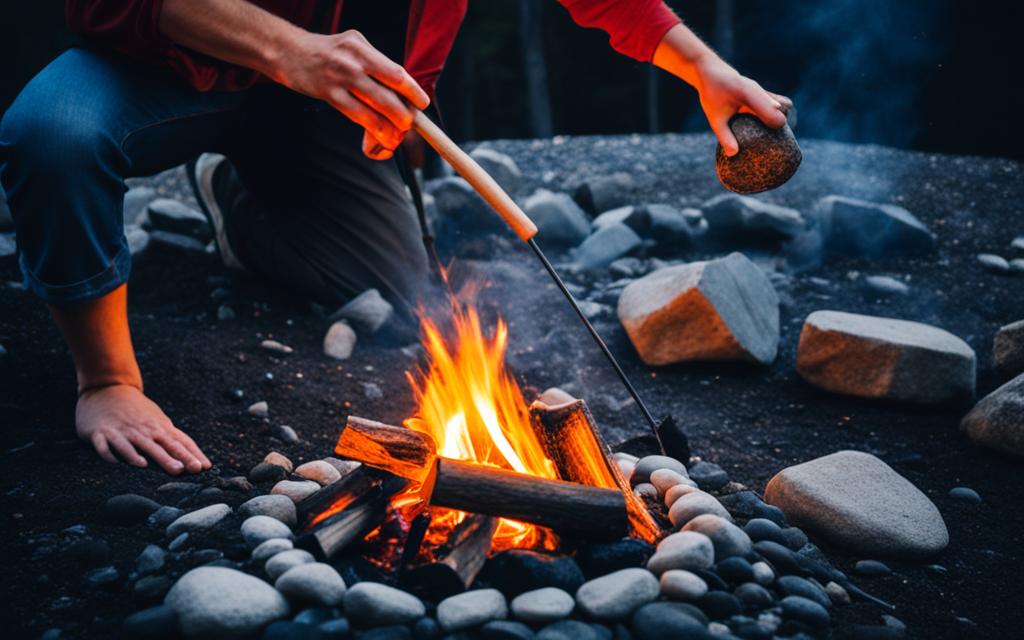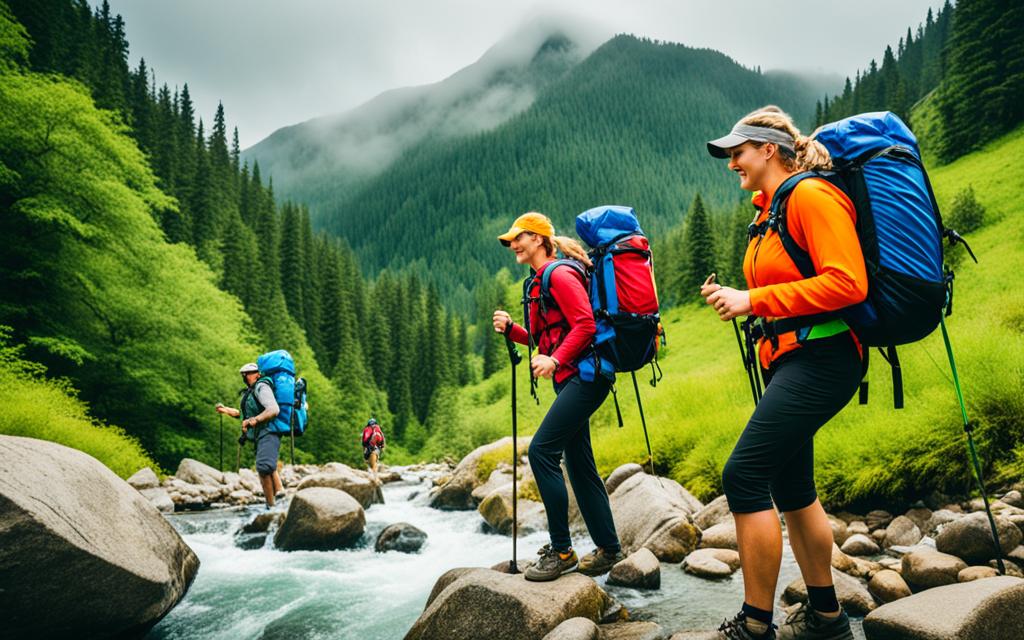When it comes to camping, safety should always be a top priority. Whether you’re an experienced adventurer or a novice camper, taking precautions and being prepared can make all the difference in ensuring a safe and enjoyable outdoor experience. In this section, we will provide you with essential camping safety tips to help you stay secure while immersing yourself in the beauty of the wilderness.
Key Takeaways:
- Research and plan ahead to ensure a safe camping trip.
- Create a comprehensive camping checklist to cover all your needs.
- Follow campfire safety guidelines to prevent accidents.
- Pack essential supplies and be aware of potential hazards while hiking.
- Take appropriate measures to prevent wildlife encounters and conflicts.
Preparing for a Safe Camping Trip
Before embarking on your camping adventure, it’s vital to take the necessary precautions to ensure your safety. By properly preparing, you can minimize risks and make the most of your outdoor experience. Here are some important steps to follow:
Research Your Campsite
It’s essential to thoroughly research your chosen campsite before setting off. Familiarize yourself with the area’s camping regulations, rules, and any potential hazards. Look for recent visitor reviews and check if there have been any reported safety concerns in the area. Understanding your surroundings will allow you to plan and prepare accordingly.
Check the Weather Conditions
Always stay informed about the weather conditions before heading out. Check the forecast for your camping location and note any potential storms, extreme temperatures, or other adverse weather conditions that could affect your safety. Be prepared to adapt your plans or make necessary adjustments based on the forecast.
Create a Detailed Camping Checklist
“A well-prepared checklist is the key to a successful camping trip.”
A comprehensive camping checklist ensures that you bring all the necessary equipment and supplies for a safe and enjoyable experience. Consider the essentials, such as tents, sleeping bags, cooking utensils, food, water, first aid kits, and personal safety items. Don’t forget to include items specific to your destination, such as insect repellent or bear spray for wildlife-heavy areas.
By following these preparatory steps, you’ll be better equipped to handle any unforeseen challenges and ensure a safe and enjoyable camping trip.
“Proper preparation is the foundation of a safe and successful camping adventure.”
Campsite Safety Measures
Once you’ve arrived at your campsite, it’s important to implement proper safety measures to minimize risks and keep yourself and your fellow campers safe. By following these campsite safety guidelines, you can ensure a secure and enjoyable camping experience.
1. Setting Up Your Campsite
When setting up your campsite, choose a location that is safe and free from potential hazards. Look for level ground, away from dead trees, overhead branches, or rocky areas that may pose a risk of falling objects. Be aware of any nearby bodies of water and set up a safe distance away.
2. Practicing Campfire Safety
A campfire is a quintessential part of the camping experience, but it requires careful attention to prevent accidents. Follow these campfire safety tips:
- Clear the area around the fire pit of any flammable materials, such as dry leaves or brush.
- Keep a bucket of water or a fire extinguisher nearby in case of emergencies.
- Never leave the campfire unattended and always fully extinguish it before going to bed or leaving the campsite. Make sure the fire is completely out, with no smoldering embers.
- Follow any fire regulations or restrictions in the area and use designated fire rings or pits when available.
Remember, wildfires pose a significant threat to both nature and humans, so it’s crucial to practice responsible campfire safety.
3. Securing Your Belongings
To prevent accidents and wildlife encounters at your campsite, it’s important to secure your belongings properly:
- Store food, garbage, and scented items in bear-proof containers or hang them high up in a tree away from your sleeping area.
- Keep your campsite clean, removing any food scraps or trash that may attract animals.
- Store all personal items, including toiletries and cooking utensils, in secure containers or closed vehicles to avoid attracting wildlife.
By taking these precautions, you can reduce the risk of wildlife encounters and ensure the safety of both yourself and the local wildlife.

Remember, the safety of yourself, your fellow campers, and the environment should always be a top priority. By following these campsite safety measures, you can enjoy your camping trip while minimizing risks and creating lasting memories.
Hiking and Wilderness Safety
Exploring the wilderness and going on hikes is an invigorating part of camping. However, it’s important to prioritize your safety to ensure an enjoyable experience. By following these hiking and wilderness safety tips, you can minimize risks and make the most of your outdoor adventures.
1. Plan Your Hikes
Prioritize planning before embarking on any hiking trails. Research the difficulty level, length, and terrain of the trail to ensure it aligns with your fitness level and capabilities. Be aware of any potential hazards or weather conditions that could affect your hike. It’s crucial to inform others about your hiking plans, including the trail and estimated return time, in case of emergencies.
2. Pack Essential Supplies
Be prepared for unforeseen circumstances by packing essential supplies. Carry a well-fitting backpack with plenty of water to stay hydrated throughout your hike. Don’t forget to bring a map, compass, and GPS device to navigate your way effectively. Pack energy-rich snacks, sun protection, a first aid kit, and extra layers of clothing for changing weather conditions. It’s also wise to have a whistle and flashlight for emergencies.

3. Stay Aware of Potential Hazards
While hiking in the wilderness, be mindful of the potential hazards that may arise. Keep an eye out for slippery surfaces, loose rocks, and steep ascents or descents. Be cautious around bodies of water, especially if they have strong currents. Stay on designated trails to minimize the risk of getting lost or encountering dangerous wildlife.
Remember, the wilderness is a beautiful but unpredictable place. Always respect and be aware of your surroundings.
4. Practice Leave No Trace Principles
Preserve the natural beauty of the wilderness by practicing Leave No Trace principles. Dispose of waste properly by carrying out what you carry in, including food wrappers and toilet paper. Minimize campfire impact by using established fire rings or stoves. Respect wildlife from a safe distance and refrain from feeding them. Leave nature as you found it, ensuring future campers and hikers can enjoy it too.
5. Seek Knowledge and Training
Enhance your hiking and wilderness safety skills by seeking knowledge and training. Take wilderness survival courses, learn basic first aid techniques, and familiarize yourself with local flora and fauna. The more you know, the better equipped you’ll be to handle unexpected situations and emergencies in the great outdoors.
By following these hiking and wilderness safety tips, you can fully enjoy the beauty and tranquility of nature while ensuring your well-being. Remember, being prepared and mindful of your surroundings is key to a safe and successful hiking experience.
Wildlife Safety Tips
When camping in certain areas, it’s essential to be aware of potential wildlife encounters and take necessary precautions for camping safety. One of the most common wildlife encounters while camping is with bears. To ensure your safety and to prevent any conflicts, here are some important wildlife safety tips:
Properly Store Food:
Keeping food secure and away from bears is crucial to avoid attracting them to your campsite. Store food in bear-resistant containers or hang it from a tree at least 10 feet off the ground and 4 feet away from the trunk. Never keep food inside your tent, as bears have a keen sense of smell and can be drawn to the scent.
Encountering a Bear:
If you come across a bear while camping, it’s important to remain calm and avoid any sudden movements. Back away slowly while facing the bear and maintain eye contact. Never run or turn your back on a bear, as this may trigger a chase response. In the unlikely event of an attack, use bear spray if available and aim for the bear’s face.
Prevent Wildlife Conflicts:
In addition to bear safety, there are other important measures to prevent wildlife conflicts while camping. Keep a clean campsite by properly disposing of all garbage and food scraps. Respect wildlife by observing from a safe distance and never approaching or feeding them. By minimizing human-wildlife interactions, you can help protect both yourself and the natural habitat.
By following these wildlife safety tips, you can have a safe and enjoyable camping experience. Remember, it’s crucial to be aware of your surroundings and take proper precautions to protect yourself, the wildlife, and the environment.